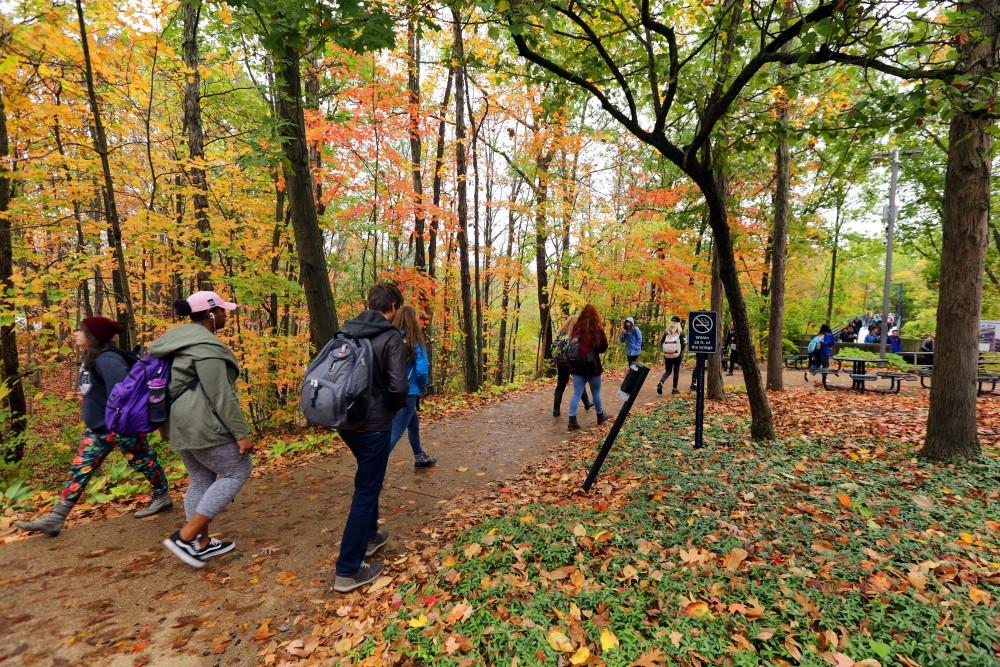Fall break proposal approved by University Academic Senate

GVL / Emily Frye Students walking on campus on Wednesday October 11, 2017.
Apr 16, 2018
The addition of a fall break to the university calendar has been many students’ wish for some time at Grand Valley State University. A proposal to implement a fall break at GVSU, initiated by student senate, has now officially been passed by the University Academic Senate (UAS).
The proposal first passed through student senate in early November 2017. UAS had been deliberating over the topic since and finally passed the resolution during its Friday, April 6, assembly.
In the fall semester, students arrive on campus and work from after Labor Day until Thanksgiving break. When they return to school, there are around three more weeks before the semester ends. Working non-stop for nearly three months can be difficult for students, while the winter semester can be more manageable because it includes a week off for spring break.
“It’s an incredible amount of time,” said student senate president Jonathan Bowman. “I know just from experience, when you’re going constantly for a whole semester, it’s a lot on students. (It’s) a really easy thing for college students who are super busy focusing on class, working jobs, to kind of forget to take care of yourself. We want to make sure students are healthy in all aspects of their lives.”
After realizing how burned out students became in the fall, student senate wrote a resolution to help add a fall break into the semester. Bowman visited the Registrar’s Office to review the academic calendar, and then senate created a task force known as the SOFAB (study of fall break task force). Students from each discipline at GVSU were represented in SOFAB and helped to create an elaborate study of seven different options to incorporate a fall break into the calendar.
“One of the biggest challenges was working with labs and clinicals for nursing students, (the College of Health Professions), engineering (and) their co-ops, (and) the College of Ed working on their student teaching,” Bowman said. “It’s definitely been a process.”
As the various GVSU colleges have different schedules of their own, student senate considered a proposal that would start school earlier. But this would have required a shift in the schedule for Transitions and on-campus housing. Summer training for resident assistants and faculty would have to start earlier, too, and vacation would be cut short for professors.
“(It’s a) complicated change,” Bowman said. “The biggest thing is we want to make sure we have an equal amount of days in the classroom. We can’t take days off school and just lose those days. We want to make sure fall and winter semester have the same amount of time in classrooms so it’s fair for all students and classes. That’s the biggest concern.”
Despite the complications past senators encountered, SOFAB was still able to narrow the choices down to one option, which was passed by the Executive Committee of the Senate on Friday, April 6. Now Bowman will take “Plan A” to GVSU President Thomas Haas’ cabinet to discuss the benefits students and faculty have expressed.
UAS chair Felix Ngassa still expects resistance from the College of Health Professions and departments of nursing, sciences and engineering. The bill includes the option of an opt-out, a path departments can take to their dean and to the Office of the Provost to keep their students in the classroom. Bowman said they will still run into the problem of trying to fit Campus Life Night into the schedule if the new proposal passes.
“Like anything else, change is always very difficult to come by,” Ngassa said. “If they accept (the bill), we’re looking at maybe the next two years.”
Although it is not official, SOFAB has planned to add a day of school the Tuesday after Labor Day (typically taken off due to Campus Life Night) and to take Monday and Tuesday off in the ninth week of the semester, giving students a chance to catch their breath after midterm exams. Because the calendar is already set for this coming fall, Bowman foresees the change taking place in the 2019-20 academic year.






















